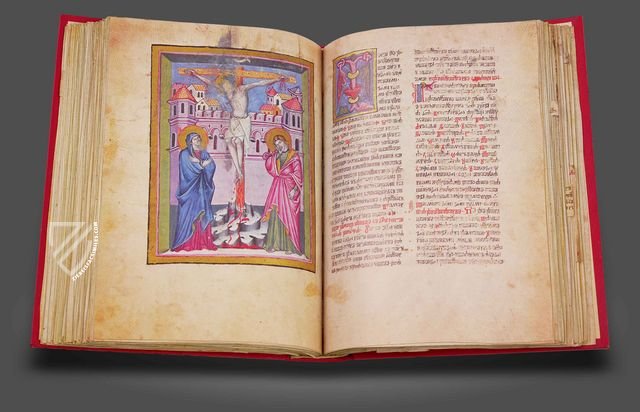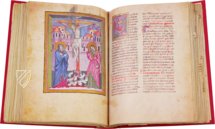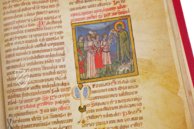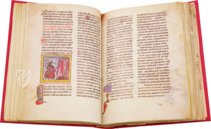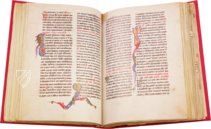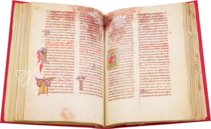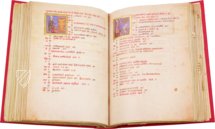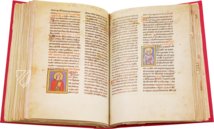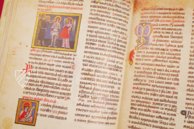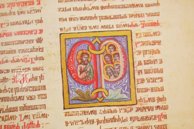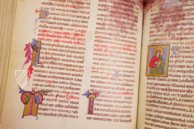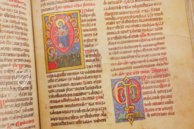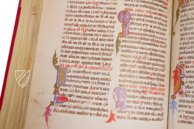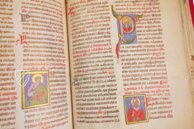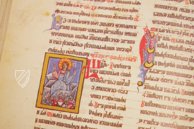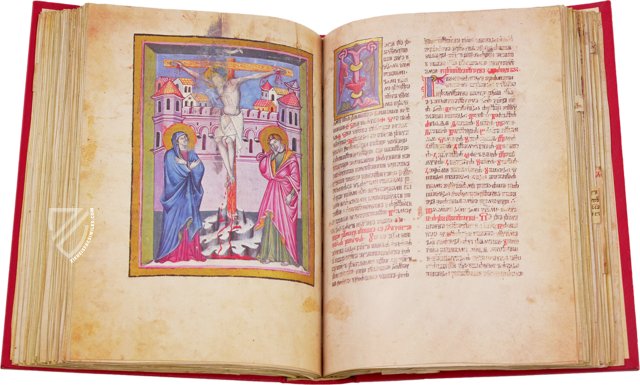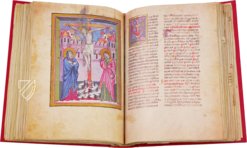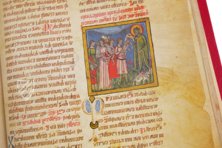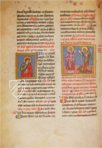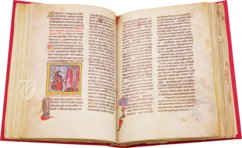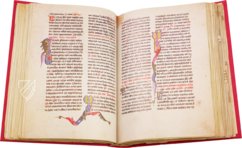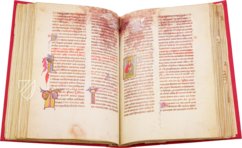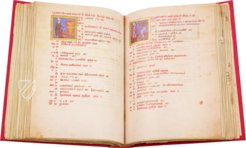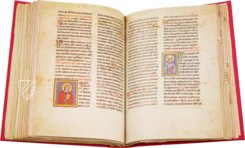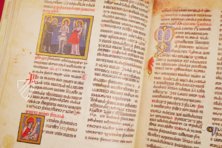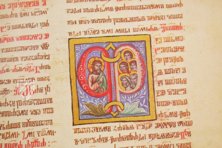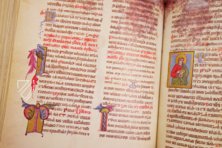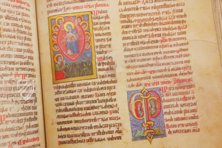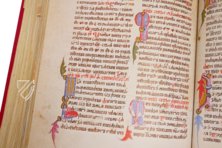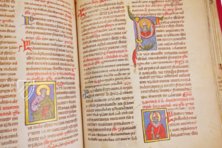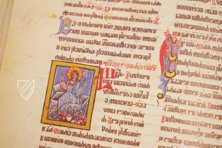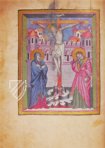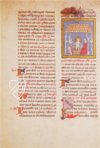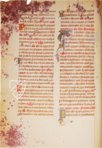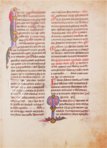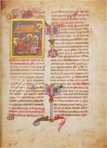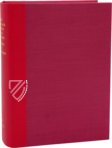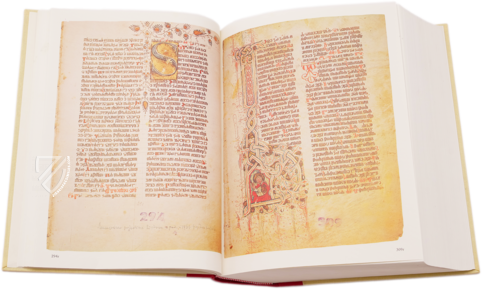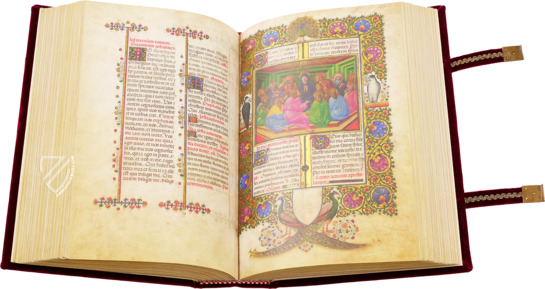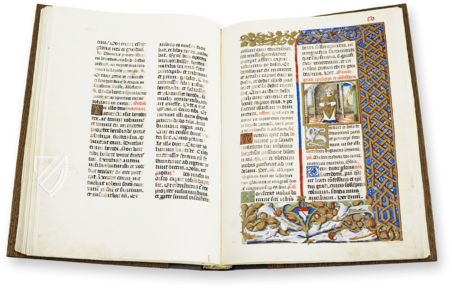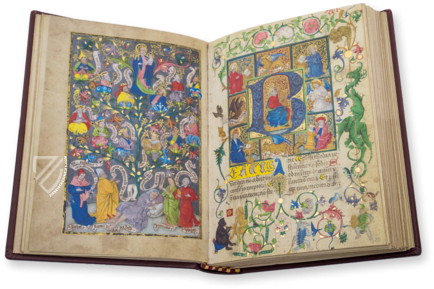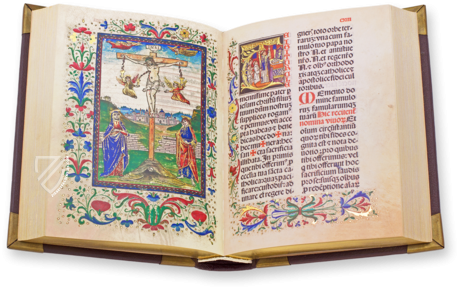Missale Hervoiae Ducis Spalatensis croatico-glagoliticum
(1,000€ - 3,000€)
The Missale Hervoiae occupies a special place in the history of the Croatian-Slavonic language. Made for a high-ranking noble of the Hungarian-Croatian Kingdom, this is a luxury manuscript with 96 colorful miniatures and around 380 large ornamental initials. The Missale Hervoiae is one of the most important texts of Croatian Glagolitic literature, which had been banned for centuries, and was only to be re-established in 1248 by Pope Innocence IV. Heavily influenced by Byzantine art, its combination of eastern and western principles in terms of composition and contents has secured it a place in the regional and transregional history of art. The miniatures illustrate scenes from both the Old and the New Testaments, allegories of the months with characteristic scenes from everyday life.
Missale Hervoiae Ducis Spalatensis Croatico-Glagoliticum
Of the numerous missals written in the Croatian-Slavonic Church language of the 14th–15th century, the Missale Hervoiae deserves special mention. It represents the most beautifully and richly embellished illuminated codex of this group with precious miniatures of outstanding artistic quality. The text is written in the Church Slavonic language, with its typical angular Croat Glagolitic letters, a script still in use today in the liturgical books of the Croatian coastland on the northern Adriatic. The sumptuous manuscript was made for a high-ranking personality, namely Hrvoje Vukcic Hrvatinic, Duke of Split and governor of the provinces of Croatia, Dalmatia, and Bosnia, which were ruled by the Croat-Hungarian King Ladislas. The value of this manuscript has likely been the reason for its turbulent destiny. Looted by the Turks, it was brought to the Sultan’s library at Constantinople. Later it was believed to be lost for a long time, until it was finally rediscovered in the Topkapı Sarayı Museum in 1963. A total of 96 colorful miniatures and around 380 large ornamental initials among numerous smaller ones make this manuscript a unique work of art. The Missale Hervoiae is not only an essential work for philological, historical, and liturgical research but also for the history of art and culture.
A Unique Testimony to Croatian Glagolitic Literature
According to an inscription contained in the book, the Missale Hervoiae was written down in Split by a resident calligrapher named Butko. He used the angular Glagolitic script whose invention has been ascribed to the two monks and Slavic apostles named Cyril and Methodius from Thessalonica. This script is based on Greek minuscule with elements borrowed from oriental alphabets and is still used today in services according to Roman use. The Missale Hervoiae is one of the most important texts of Croatian Glagolitic literature, which had been banned over centuries, and was only to be re-established in 1248 by Pope Innocence IV. Based on its contents, it constitutes a so-called complete Missal, a form unified in the 13th century by the Franciscans on which all Croatian Glagolitic manuscripts were based.
The Sumptuous Decorative Apparatus
The 96 miniatures illustrate scenes from both the Old and the New Testaments, showing not only prophets, evangelists and apostles but also several saints with their attributes. Allegories of the months are depicted in characteristic scenes and incidents of life. The miniatures contain both western elements and details of oriental and Byzantine origin. This allows us to place the codex in southern Italy, in the close artistic circle of the Anjou dynasty whose realm then also included the area of Dalmatia and with whom Duke Hrvoje was in close contact. From southern Italy, where Byzantine monks and Christians from the eastern regions had found shelter from prosecution in the 8th and 9th centuries, the Byzantine oriental compositions infiltrated western iconography and subsequently the art of the Dalmatian coastland. The initials, due to their imaginative decoration, attract the attention of the beholder. The bands, foliage and flowers forming the initials are ornate with clasps, nodes, linear motifs, zoomorphic ornament such as heads of birds, serpents and snakes, and frequently even with anthropomorphic elements. The particular value of the Missale Hervoiae lies in its combination of eastern and western principles in terms of composition and contents, thus making it a truly deluxe work and securing it a place in the regional and transregional history of art.
Codicology
- Size / Format
- 494 pages / 30.6 × 23.0 cm
- Origin
- Croatia
- Date
- Ca. 1403
- Epochs
- Style
- Genre
- Language
- Illustrations
- Nearly every page is illuminated: 96 miniatures including 3 full-page miniatures, 380 historiated initials, and numerous smaller initials
- Patron
- Hrvoje Vukcic Hrvatinic, Duke of Split and governor of the provinces of Croatia, Dalmatia, and Bosnia (ca. 1350–1416)
- Artist / School
- Butko (scribe)
Missale Hervoiae Ducis Spalatensis croatico-glagoliticum
The Adoration of the Shepherds
This small but masterfully executed miniature condenses the events of Luke 2:1-20 in an artful and clever manner. Swaddled in a red and white blanket, the Christ Child with golden cross halo is flanked by Mary and Joseph as an angel flies out from behind the roof to announce the birth to shepherds in a field nearby. One of them appears on the right dressed in a red tunic and his animals appear lying on the ground in front of the manger or standing next to it to keep the newborn warm.
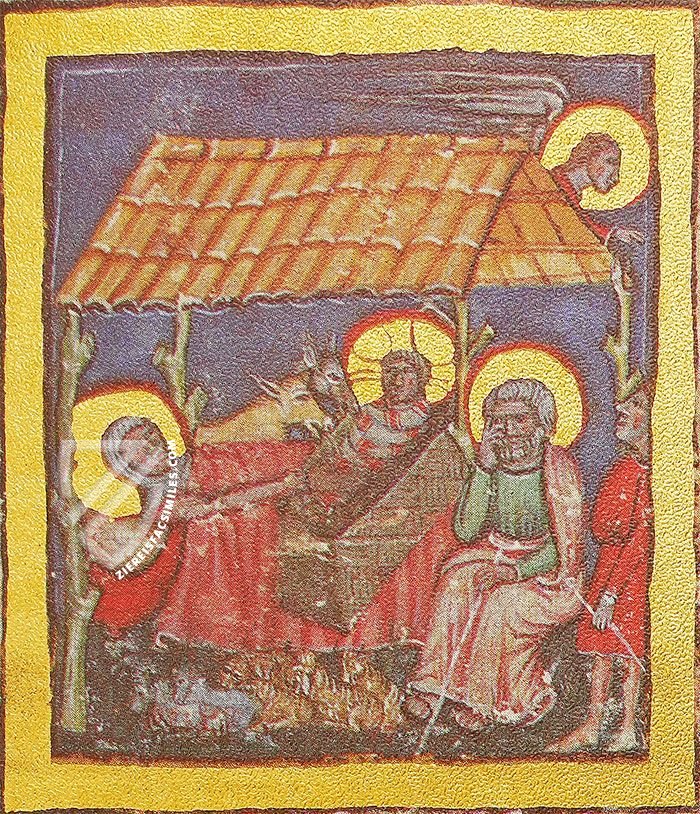
Missale Hervoiae Ducis Spalatensis croatico-glagoliticum
Crucifixion
Although water damage has unfortunately obscured the face of Jesus, this full-page miniature is of excellent quality, nonetheless. Even the gold-pink-green border has been executed in a manner that makes it appear almost three-dimensional as though it were an actual wooden frame for a panel painting.
The combination of the architectural background and the positioning of the three figures accounts for the perfectly balanced spatial composition of the miniature, which was painted with an unusual color palette dominated by light shades of purple and pink contrasted by Christ’s pale grey skin and flowing red blood. The strange, enigmatic facial expressions of Mary and St. John are a combination of grimace and smile and leave a lasting impression on the beholder.
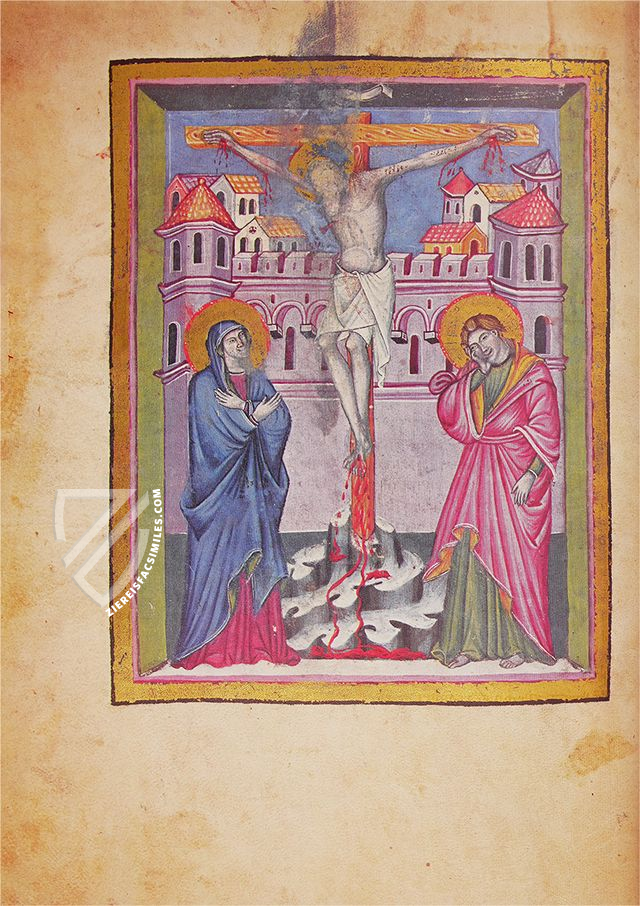
#1 Missale Hervoiae Ducis Spalatensis croatico-glagoliticum
Languages: English, German, Latin
The scholarly commentary volume includes a complete and annotated transcription of the Missal text in Latin script, as well as several articles on the historical-liturgical structure, illumination, language and script, and a valuable directory of the Gospel readings.
(1,000€ - 3,000€)
- Treatises / Secular Books
- Apocalypses / Beatus
- Astronomy / Astrology
- Bestiaries
- Bibles / Gospels
- Chronicles / History / Law
- Geography / Maps
- Saints' Lives
- Islam / Oriental
- Judaism / Hebrew
- Single Leaf Collections
- Leonardo da Vinci
- Literature / Poetry
- Liturgical Manuscripts
- Medicine / Botany / Alchemy
- Music
- Mythology / Prophecies
- Psalters
- Other Religious Books
- Games / Hunting
- Private Devotion Books
- Other Genres
- Afghanistan
- Armenia
- Austria
- Belgium
- Belize
- Bosnia and Herzegovina
- China
- Colombia
- Costa Rica
- Croatia
- Cyprus
- Czech Republic
- Denmark
- Egypt
- El Salvador
- Ethiopia
- France
- Germany
- Greece
- Guatemala
- Honduras
- Hungary
- India
- Iran
- Iraq
- Israel
- Italy
- Japan
- Jordan
- Kazakhstan
- Kyrgyzstan
- Lebanon
- Liechtenstein
- Luxembourg
- Mexico
- Morocco
- Netherlands
- Palestine
- Panama
- Peru
- Poland
- Portugal
- Romania
- Russia
- Serbia
- Spain
- Sri Lanka
- Sweden
- Switzerland
- Syria
- Tajikistan
- Turkey
- Turkmenistan
- Ukraine
- United Kingdom
- United States
- Uzbekistan
- Vatican City
- A. Oosthoek, van Holkema & Warendorf
- Aboca Museum
- Ajuntament de Valencia
- Akademie Verlag
- Akademische Druck- u. Verlagsanstalt (ADEVA)
- Aldo Ausilio Editore - Bottega d’Erasmo
- Alecto Historical Editions
- Alkuin Verlag
- Almqvist & Wiksell
- Amilcare Pizzi
- Andreas & Andreas Verlagsbuchhandlung
- Archa 90
- Archiv Verlag
- Archivi Edizioni
- Arnold Verlag
- ARS
- Ars Magna
- ArtCodex
- AyN Ediciones
- Azimuth Editions
- Badenia Verlag
- Bärenreiter-Verlag
- Belser Verlag
- Belser Verlag / WK Wertkontor
- Benziger Verlag
- Bernardinum Wydawnictwo
- BiblioGemma
- Biblioteca Apostolica Vaticana (Vaticanstadt, Vaticanstadt)
- Bibliotheca Palatina Faksimile Verlag
- Bibliotheca Rara
- Boydell & Brewer
- Bramante Edizioni
- Bredius Genootschap
- Brepols Publishers
- British Library
- C. Weckesser
- Caixa Catalunya
- Canesi
- CAPSA, Ars Scriptoria
- Caratzas Brothers, Publishers
- Carus Verlag
- Casamassima Libri
- Centrum Cartographie Verlag GmbH
- Chavane Verlag
- Christian Brandstätter Verlag
- Circulo Cientifico
- Club Bibliófilo Versol
- Club du Livre
- CM Editores
- Collegium Graphicum
- Collezione Apocrifa Da Vinci
- Comissão Nacional para as Comemorações dos Descobrimentos Portugueses
- Coron Verlag
- Corvina
- CTHS
- D. S. Brewer
- Damon
- De Agostini/UTET
- De Nederlandsche Boekhandel
- De Schutter
- Deuschle & Stemmle
- Deutscher Verlag für Kunstwissenschaft
- DIAMM
- Droz
- E. Schreiber Graphische Kunstanstalten
- Ediciones Boreal
- Ediciones Grial
- Ediclube
- Edições Inapa
- Edilan
- Editalia
- Edition Deuschle
- Edition Georg Popp
- Edition Leipzig
- Edition Libri Illustri
- Editiones Reales Sitios S. L.
- Éditions de l'Oiseau Lyre
- Editions Medicina Rara
- Editorial Casariego
- Editorial Mintzoa
- Editrice Antenore
- Editrice Velar
- Edizioni Edison
- Egeria, S.L.
- Eikon Editores
- Electa
- Emery Walker Limited
- Enciclopèdia Catalana
- Eos-Verlag
- Ephesus Publishing
- Ernst Battenberg
- Eugrammia Press
- Extraordinary Editions
- Fackelverlag
- Facsimila Art & Edition
- Facsimile Editions Ltd.
- Facsimilia Art & Edition Ebert KG
- Faksimile Verlag
- Feuermann Verlag
- Folger Shakespeare Library
- Franco Cosimo Panini Editore
- Friedrich Wittig Verlag
- Fundación Hullera Vasco-Leonesa
- G. Braziller
- Gabriele Mazzotta Editore
- Gebr. Mann Verlag
- Gesellschaft für graphische Industrie
- Getty Research Institute
- Giovanni Domenico de Rossi
- Giunti Editore
- Graffiti
- Grafica European Center of Fine Arts
- Guido Pressler
- Guillermo Blazquez
- Gustav Kiepenheuer
- H. N. Abrams
- Harrassowitz
- Harvard University Press
- Helikon
- Hendrickson Publishers
- Henning Oppermann
- Herder Verlag
- Hes & De Graaf Publishers
- Hoepli
- Holbein-Verlag
- Houghton Library
- Hugo Schmidt Verlag
- Idion Verlag
- Il Bulino, edizioni d'arte
- ILte
- Imago
- Insel Verlag
- Insel-Verlag Anton Kippenberger
- Instituto de Estudios Altoaragoneses
- Instituto Nacional de Antropología e Historia
- Introligatornia Budnik Jerzy
- Istituto dell'Enciclopedia Italiana - Treccani
- Istituto Ellenico di Studi Bizantini e Postbizantini
- Istituto Geografico De Agostini
- Istituto Poligrafico e Zecca dello Stato
- Italarte Art Establishments
- Jan Thorbecke Verlag
- Johnson Reprint Corporation
- Josef Stocker
- Josef Stocker-Schmid
- Jugoslavija
- Karl W. Hiersemann
- Kasper Straube
- Kaydeda Ediciones
- Kindler Verlag / Coron Verlag
- Kodansha International Ltd.
- Konrad Kölbl Verlag
- Kurt Wolff Verlag
- La Liberia dello Stato
- La Linea Editrice
- La Meta Editore
- Lambert Schneider
- Landeskreditbank Baden-Württemberg
- Leo S. Olschki
- Les Incunables
- Liber Artis
- Library of Congress
- Libreria Musicale Italiana
- Lichtdruck
- Lito Immagine Editore
- Lumen Artis
- Lund Humphries
- M. Moleiro Editor
- Maison des Sciences de l'homme et de la société de Poitiers
- Manuscriptum
- Martinus Nijhoff
- Maruzen-Yushodo Co. Ltd.
- MASA
- Massada Publishers
- McGraw-Hill
- Metropolitan Museum of Art
- Militos
- Millennium Liber
- Müller & Schindler
- Nahar - Stavit
- Nahar and Steimatzky
- National Library of Wales
- Neri Pozza
- Nova Charta
- Oceanum Verlag
- Odeon
- Orbis Mediaevalis
- Orbis Pictus
- Österreichische Staatsdruckerei
- Oxford University Press
- Pageant Books
- Parzellers Buchverlag
- Patrimonio Ediciones
- Pattloch Verlag
- PIAF
- Pieper Verlag
- Plon-Nourrit et cie
- Poligrafiche Bolis
- Presses Universitaires de Strasbourg
- Prestel Verlag
- Princeton University Press
- Prisma Verlag
- Priuli & Verlucca, editori
- Pro Sport Verlag
- Propyläen Verlag
- Pytheas Books
- Quaternio Verlag Luzern
- Reales Sitios
- Recht-Verlag
- Reichert Verlag
- Reichsdruckerei
- Reprint Verlag
- Riehn & Reusch
- Roberto Vattori Editore
- Rosenkilde and Bagger
- Roxburghe Club
- Salerno Editrice
- Saltellus Press
- Sandoz
- Sarajevo Svjetlost
- Schöck ArtPrint Kft.
- Schulsinger Brothers
- Scolar Press
- Scrinium
- Scripta Maneant
- Scriptorium
- Shazar
- Siloé, arte y bibliofilia
- SISMEL - Edizioni del Galluzzo
- Sociedad Mexicana de Antropología
- Société des Bibliophiles & Iconophiles de Belgique
- Soncin Publishing
- Sorli Ediciones
- Stainer and Bell
- Studer
- Styria Verlag
- Sumptibus Pragopress
- Szegedi Tudomànyegyetem
- Taberna Libraria
- Tarshish Books
- Taschen
- Tempus Libri
- Testimonio Compañía Editorial
- Thames and Hudson
- The Clear Vue Publishing Partnership Limited
- The Facsimile Codex
- The Folio Society
- The Marquess of Normanby
- The Richard III and Yorkist History Trust
- Tip.Le.Co
- TouchArt
- TREC Publishing House
- TRI Publishing Co.
- Trident Editore
- Tuliba Collection
- Typis Regiae Officinae Polygraphicae
- Union Verlag Berlin
- Universidad de Granada
- University of California Press
- University of Chicago Press
- Urs Graf
- Vallecchi
- Van Wijnen
- VCH, Acta Humaniora
- VDI Verlag
- VEB Deutscher Verlag für Musik
- Verlag Anton Pustet / Andreas Verlag
- Verlag Bibliophile Drucke Josef Stocker
- Verlag der Münchner Drucke
- Verlag für Regionalgeschichte
- Verlag Styria
- Vicent Garcia Editores
- W. Turnowski Ltd.
- W. Turnowsky
- Waanders Printers
- Wiener Mechitharisten-Congregation (Wien, Österreich)
- Wissenschaftliche Buchgesellschaft
- Wissenschaftliche Verlagsgesellschaft
- Wydawnictwo Dolnoslaskie
- Xuntanza Editorial
- Zakład Narodowy
- Zollikofer AG

